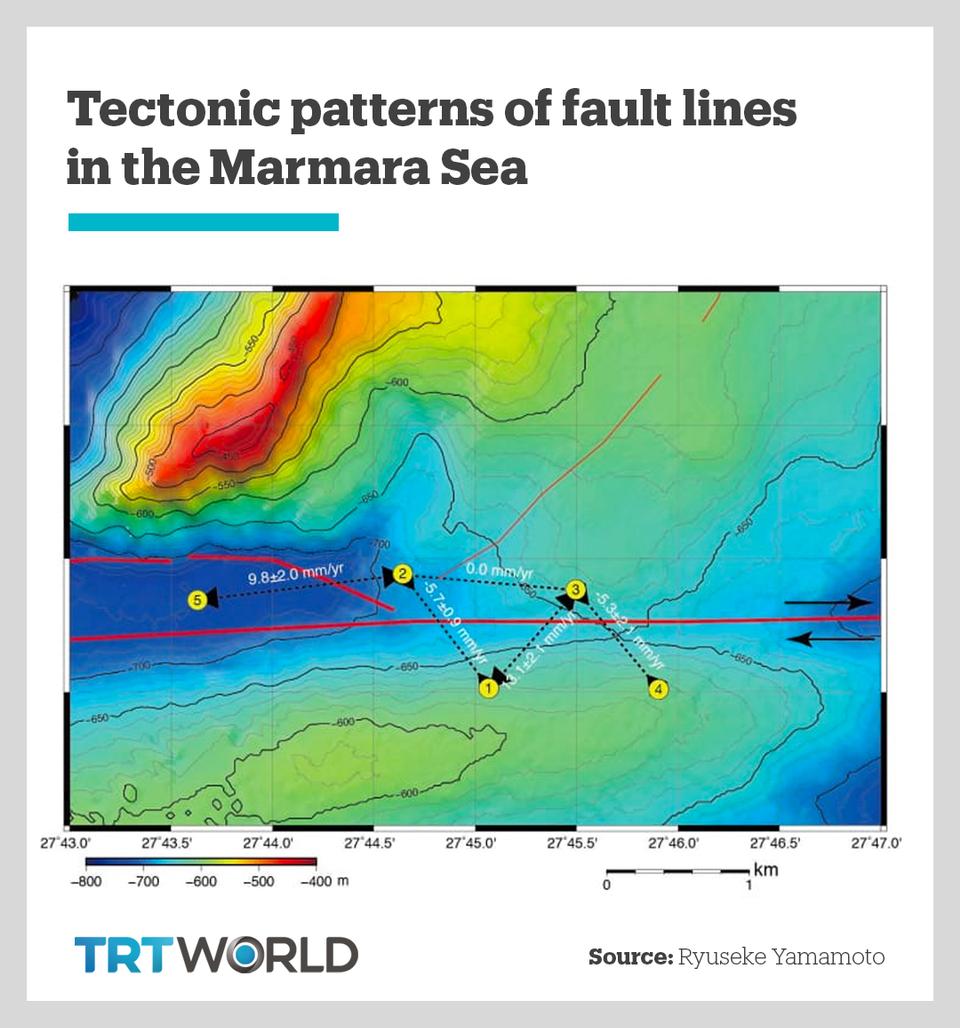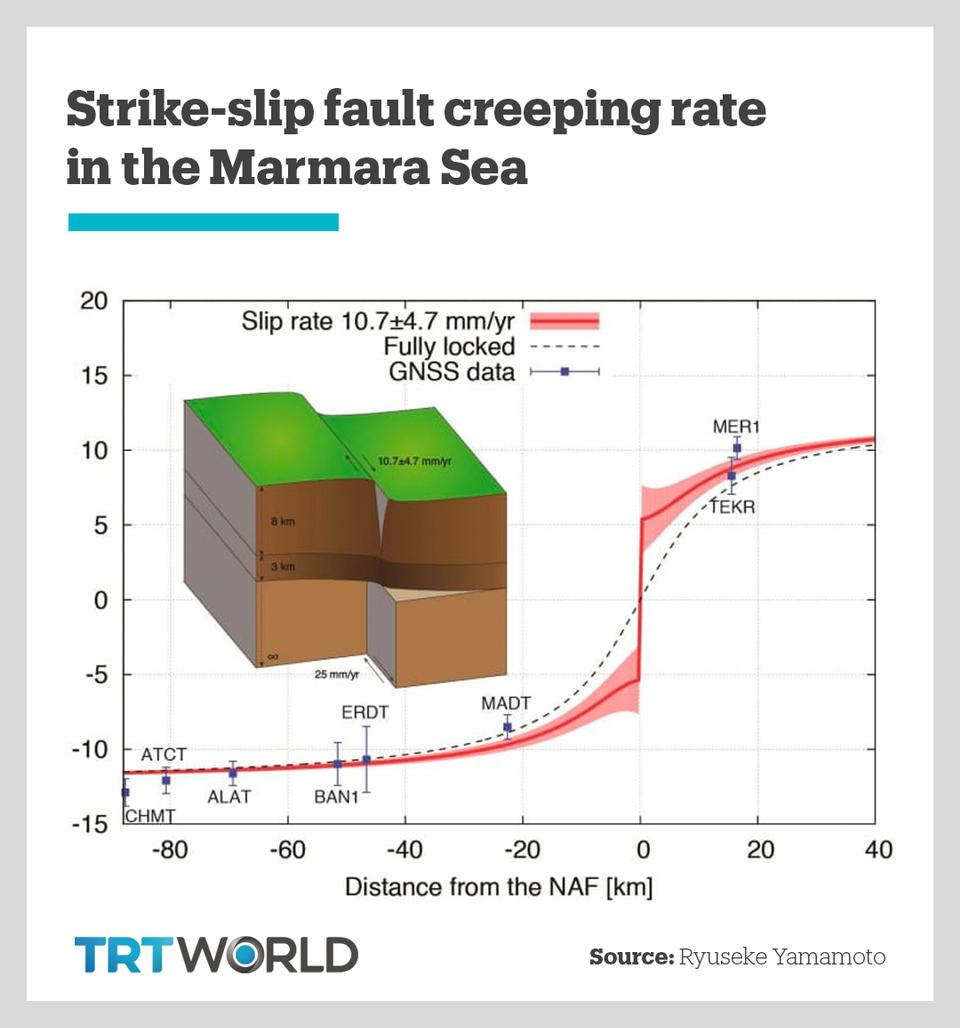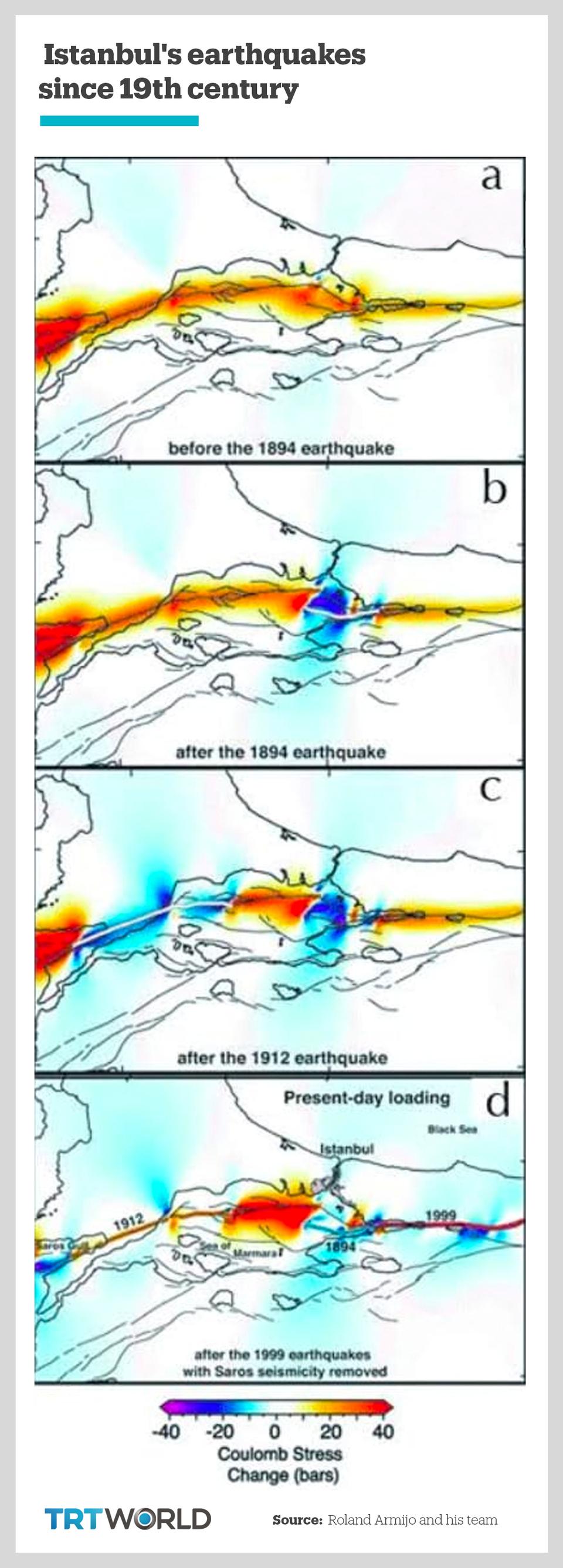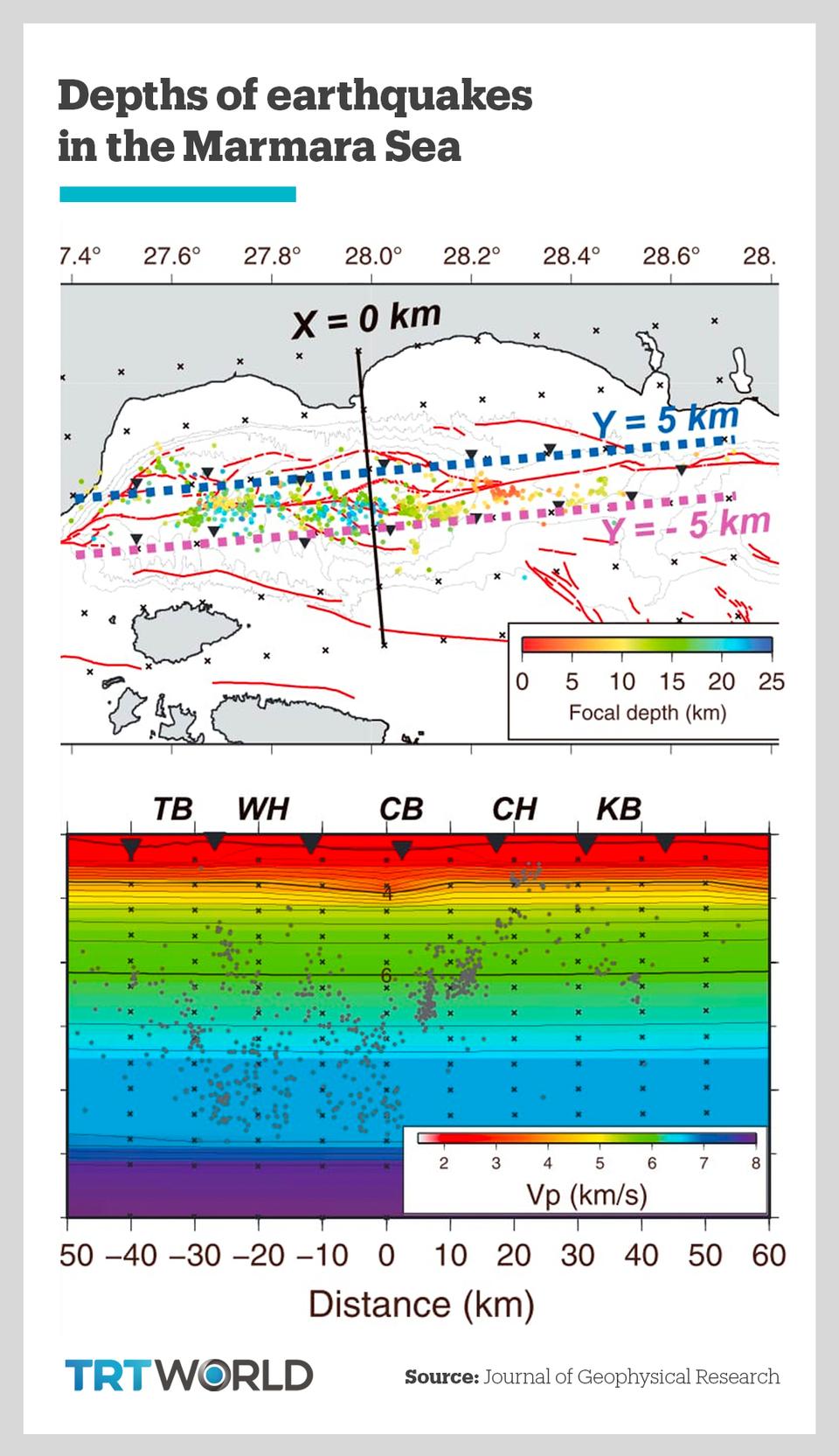
Is Istanbul headed for another big earthquake?
MURAT SOFUOGLU
31 JAN 2020
In September last year, Istanbul was shaken by a magnitude 5.8 earthquake, triggering widespread panic. This is what experts think the future might hold for the city.
Istanbul is one of the world’s most picturesque cities located along the banks of the Bosphorous - a globally strategic waterway that divides Europe and Asia. What lies beneath the city though, doesn’t paint as beautiful a picture.
The city lies directly atop the dangerous North Anatolian fault line, marking the border between the Eurasian and Anatolian plates, the scene of some of the world’s most destructive earthquakes in history, claiming the lives of tens of thousands.
In the last five centuries, Istanbul has seen at least seven big earthquakes in 1509, 1719, 1754, 1766, 1894 and 1912. In 1999, the Izmit earthquake, the most recent big one killed several hundred residents of Istanbul along with 16,000 people living in the Marmara and northwest Black Sea regions.
Istanbul is sandwiched between the Black Sea in the north and the Sea of Marmara to the south.
On January 24 this year, another deadly earthquake with a magnitude of 6.8 hit Turkey’s eastern province of Elazig and its neighbouring cities, killing at least 41 people and wounding more than 1,600.
On September 26, it was once again jolted by a magnitude 5.8 earthquake, which panicked Istanbulites, triggering a long debate about the possibilities of another ‘big one’ in the city.
Which faults could affect Istanbul?
Sener Usumezsoy, who looks more like a bodybuilder or a cowboy than a geology professor, speaks with authority about the ancient fault lines of Istanbul, which lay underneath the waters of the Marmara Sea, located between the Bosphorus and the Dardanelles straits.
He is one of Turkey’s most prominent earthquake experts and remains measured about what might lie ahead for Istanbul
.

Sener Usumezsoy, a popular Turkish geology professor, speaks to TRT World about Istanbul’s earthquake risks in the city's Kadikoy district. In the picture behind him, the Sea of Marmara, under which some dangerous fault lines lay down. (Murat Sofuoglu / TRTWorld)
First and foremost, Usumezsoy thinks that while there are some risks for Istanbul, people should not fear a ‘big one’ because the fault lines beneath the Marmara Sea do not seem to contain the structure that could lead to a powerful earthquake.
Behind the presumed inevitability of a devastating earthquake lies one major misunderstanding. There is a misconception that the inactive north boundary fault line between Tuzla and Silivri, very close to Istanbul’s city centre, is part of the active North Anatolian fault, which has led to devastating earthquakes in the past across Turkey from east to west, according to Usumezsoy.
 (Samet Catak/Enes Danis / TRTWorld)
(Samet Catak/Enes Danis / TRTWorld)In addition to this misunderstanding, the two big earthquakes in the Marmara Sea — which were triggered by the North Anatolian fault line in the late 19th Century and early 20th Century — have decreased the probability of a big earthquake in Istanbul, Usumezsoy says.
"In 1912, the western edge of the restless North Anatolian fault was broken in mainly two areas — one is close to the Tekirdag Basin, and another one is close to the Silivri Basin in the Marmara Sea," Usumezsoy explains.
As a result, currently, the fault line does not have enough seismic energy to lead to a big earthquake, the professor claims.
The 1912 earthquake in Tekirdag province was extremely destructive, with an estimated magnitude of 7.4 and killed around 3,000 people destroying nearly 25,000 houses in its wake.
Since 1912, seismologists have been debating whether the broken fault has accumulated considerable stress, and could lead to another big earthquake.
"Strong earthquakes occur when the fault zone becomes locked. Then tectonic strain accumulates, and the seismic energy is released in an earthquake," said Dietrich Lange, a leading academic for the GEOMAR Helmholtz Centre for Ocean Research Kiel (Germany), who conducted a comprehensive study in the summer on the fault lines in the Marmara Sea.
Lange believes that the North Anatolian fault has built up enough tectonic strain to trigger a big earthquake.
But Usumezsoy disagrees, saying that the latest Japanese research proves otherwise.

The map shows bathymetric features and the layout of five seafloor extensometers in an area close to the Silivri Basin in the Sea of Marmara. These measurements show that there are movements or creepings between stations designated by arrows and numbers, which indicate that the Silivri fault is not locked and as a result do not accumulate essential stress to trigger a big earthquake. (Samet Catak/Enes Danis / TRTWorld)
“If this fault has become locked, accumulating two centimetres tectonic strain per year, that means it should have accumulated at least two metres strain until today,” Usumezsoy says.
“However, research conducted by Japanese showed that in this part of the Marmara Sea, the fault has not been locked without accumulating two centimetres strain. Instead, much of the fault is creeping, which amounts to 1.5 centimetre per year,” he said.
Therefore, the probability of a big earthquake is significantly diminished, according to him.
“If this fault has become locked, accumulating two centimetres tectonic strain per year, that means it should have accumulated at least two metres strain until today,” Usumezsoy says.
“However, research conducted by Japanese showed that in this part of the Marmara Sea, the fault has not been locked without accumulating two centimetres strain. Instead, much of the fault is creeping, which amounts to 1.5 centimetre per year,” he said.
Therefore, the probability of a big earthquake is significantly diminished, according to him.

Strike-slip faults are vertical fractures where the blocks have mostly moved horizontally, building up strain and eventually leading to earthquakes. Turkey’s dangerous North Anatolian Fault (NAF) is a strike-slip fault. The map shows that NAF in the Sea of Marmara is not locked, instead it has about 1.5 centimetre slip rate per year, meaning that it is not producing enough strain to trigger a big earthquake. (Samet Catak/Enes Danis / TRTWorld)
Nearly 20 years before the 1912 earthquake, in 1894, the North Anatolian fault also broke on its south eastern edge, where it was moving from the Armutlu Peninsula westward to the Cinarcik Basin, in the Marmara Sea.
As a result, in this area, the North Anatolian fault does not appear to have enough seismic energy to lead to a powerful earthquake, affecting Istanbul, Usumezsoy asserts.
The 1894 earthquake killed hundreds of people and led to enormous destruction inside Istanbul’s old city, leaving its mark on the ancient metropolis’s landmarks from the monumental Galata Tower to the city's Byzantium-era walls.
Nearly 20 years before the 1912 earthquake, in 1894, the North Anatolian fault also broke on its south eastern edge, where it was moving from the Armutlu Peninsula westward to the Cinarcik Basin, in the Marmara Sea.
As a result, in this area, the North Anatolian fault does not appear to have enough seismic energy to lead to a powerful earthquake, affecting Istanbul, Usumezsoy asserts.
The 1894 earthquake killed hundreds of people and led to enormous destruction inside Istanbul’s old city, leaving its mark on the ancient metropolis’s landmarks from the monumental Galata Tower to the city's Byzantium-era walls.

(Samet Catak/Enes Danis / TRTWorld)
Since the last big one in 1999, the pressure on the North Anatolian fault in the Marmara Sea has concentrated on its southern branch. It is moving south, close to the southern shores of the Marmara Sea, according to Usumezsoy.
That means the North Anatolian fault’s southern branch, which is more active and under pressure, is moving further away from Istanbul.
Quake debate
Despite Usumezsoy’s assurances, after the recent earthquake in Silivri Basin, the big Istanbul earthquake debate resurfaced as both ordinary folks and experts passionately argue about its potential timing and magnitude.
The 4.6 and 5.8 earthquakes happened in the Silivri Basin, where a separate fault line in the middle of the Marmara Sea, which lies northward, was broken twice in late September. (Map 1)
No casualties were reported, but several buildings collapsed in Istanbul, and many were left marked by cracks
Since the last big one in 1999, the pressure on the North Anatolian fault in the Marmara Sea has concentrated on its southern branch. It is moving south, close to the southern shores of the Marmara Sea, according to Usumezsoy.
That means the North Anatolian fault’s southern branch, which is more active and under pressure, is moving further away from Istanbul.
Quake debate
Despite Usumezsoy’s assurances, after the recent earthquake in Silivri Basin, the big Istanbul earthquake debate resurfaced as both ordinary folks and experts passionately argue about its potential timing and magnitude.
The 4.6 and 5.8 earthquakes happened in the Silivri Basin, where a separate fault line in the middle of the Marmara Sea, which lies northward, was broken twice in late September. (Map 1)
No casualties were reported, but several buildings collapsed in Istanbul, and many were left marked by cracks
.

A man takes pictures of a damaged mosque after an earthquake in Istanbul, Turkey, September 26, 2019. (Murad Sezer / TRTWorld)
After the earthquakes in the Tekirdag Basin, the Cinarcik Basin and most recently in the Silivri Basin, all earthquake-watchers have turned their attention towards a tiny fault line in the Kumburgaz Basin, which moves from the middle of the Marmara Sea to Cekmece.
Where could another earthquake happen?
“This (Kumburgaz) fault, which has been said to have a length of 40 to 50 km, is now being expected to be broken. This is the one, which carries a risk to be broken at the moment. But because this fault is not part of the North Anatolian fault system, it can not create big earthquakes,” Usumezsoy told TRT World.
“Because the depth of the Kumburgaz fault is about 10 kilometres, it can not create an earthquake more than the magnitude of 6.5,” he said.
After the earthquakes in the Tekirdag Basin, the Cinarcik Basin and most recently in the Silivri Basin, all earthquake-watchers have turned their attention towards a tiny fault line in the Kumburgaz Basin, which moves from the middle of the Marmara Sea to Cekmece.
Where could another earthquake happen?
“This (Kumburgaz) fault, which has been said to have a length of 40 to 50 km, is now being expected to be broken. This is the one, which carries a risk to be broken at the moment. But because this fault is not part of the North Anatolian fault system, it can not create big earthquakes,” Usumezsoy told TRT World.
“Because the depth of the Kumburgaz fault is about 10 kilometres, it can not create an earthquake more than the magnitude of 6.5,” he said.

(Samet Catak/Enes Danis / TRTWorld)
The depth of the Kumburgaz fault also proves that it’s not part of the North Anatolian fault system, which traverses the lithosphere at a depth of 20 kilometres across Turkey.
The magnitude of an earthquake is calculated by measuring its length and depth. As a result, the larger the area of the fault, the larger the earthquake. The same principle applies to the depth of the fault line.
“Magnitude represents the total energy released in the earthquake, which in turn depends on the area (length times depth) of the fault where slip occurs,” says Earthquake Country Alliance, an earthquake monitoring group, which aims to increase awareness and preparedness about earthquakes and tsunamis.
But other experts like Ronald Armijo, a French scientist, come to a different conclusion based on the assumption that the Kumburgaz fault lies further than Cekmece to Yesilkoy, defending a counter-argument that the high-risk fault has a length of 70 km, which means Istanbul could face a magnitude 7.2 earthquake.
Some other experts also claim that the allegedly active fault between Silivri and Tuzla will be broken once, leading to an earthquake of a magnitude of 7.6.
Usumezsoy disagrees with them, saying they are confusing a normal and possibly dead faultline between Tuzla and Cekmece with the North Anatolian fault, which is essential to Istanbul.
“Their mistake is a vital mistake to understand the dynamics of (Istanbul’s future earthquake),” the professor concludes.
The depth of the Kumburgaz fault also proves that it’s not part of the North Anatolian fault system, which traverses the lithosphere at a depth of 20 kilometres across Turkey.
The magnitude of an earthquake is calculated by measuring its length and depth. As a result, the larger the area of the fault, the larger the earthquake. The same principle applies to the depth of the fault line.
“Magnitude represents the total energy released in the earthquake, which in turn depends on the area (length times depth) of the fault where slip occurs,” says Earthquake Country Alliance, an earthquake monitoring group, which aims to increase awareness and preparedness about earthquakes and tsunamis.
But other experts like Ronald Armijo, a French scientist, come to a different conclusion based on the assumption that the Kumburgaz fault lies further than Cekmece to Yesilkoy, defending a counter-argument that the high-risk fault has a length of 70 km, which means Istanbul could face a magnitude 7.2 earthquake.
Some other experts also claim that the allegedly active fault between Silivri and Tuzla will be broken once, leading to an earthquake of a magnitude of 7.6.
Usumezsoy disagrees with them, saying they are confusing a normal and possibly dead faultline between Tuzla and Cekmece with the North Anatolian fault, which is essential to Istanbul.
“Their mistake is a vital mistake to understand the dynamics of (Istanbul’s future earthquake),” the professor concludes.
Source: TRT World
No comments:
Post a Comment